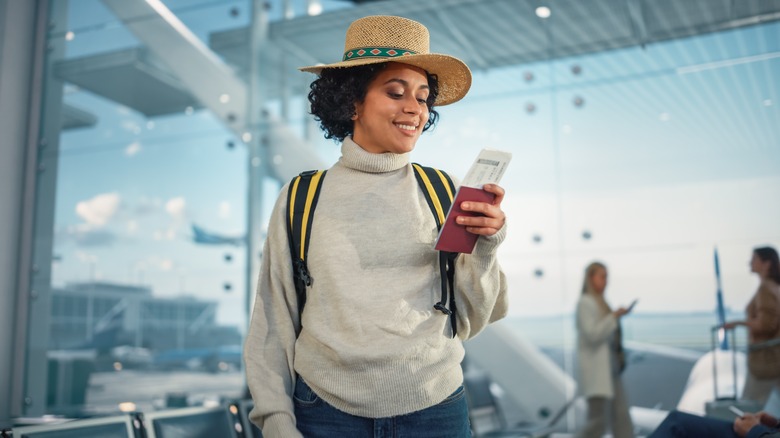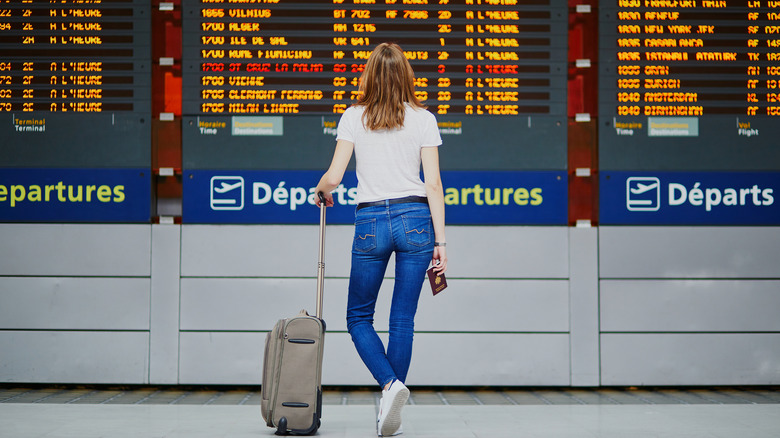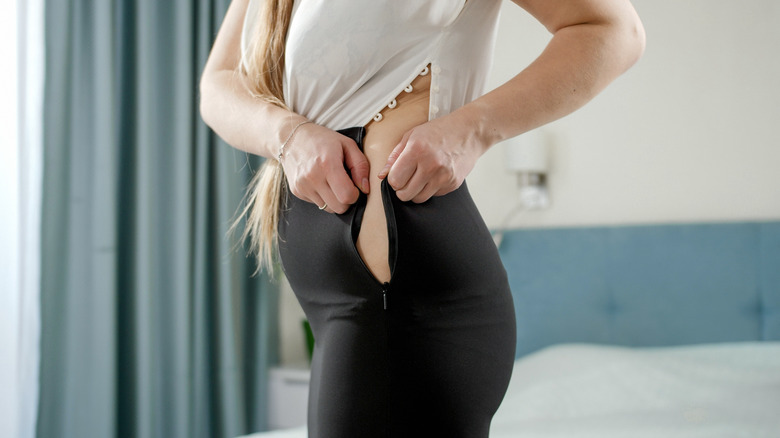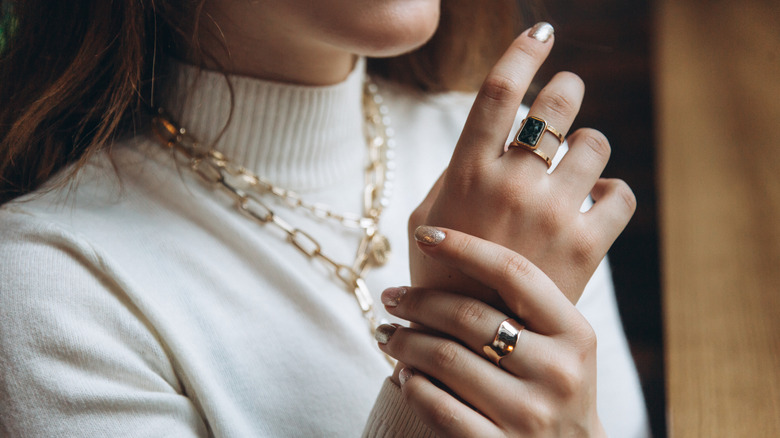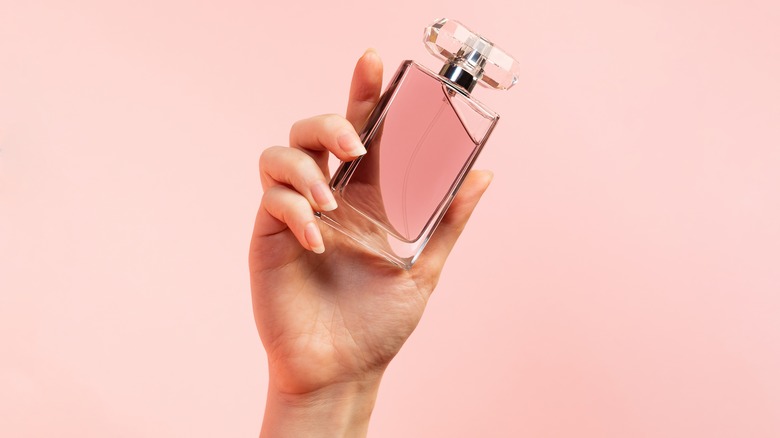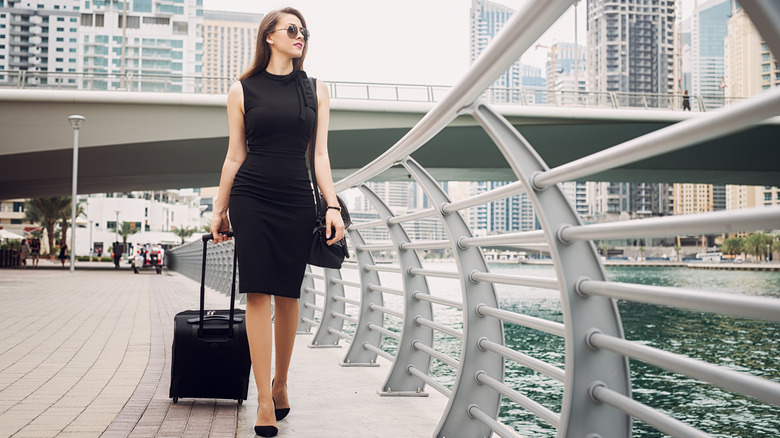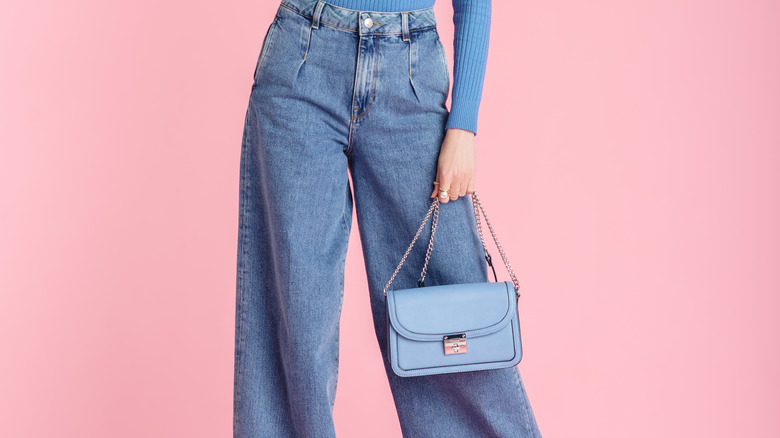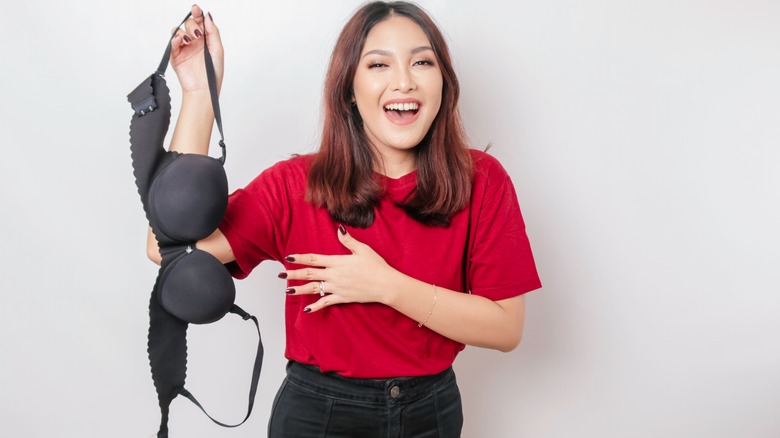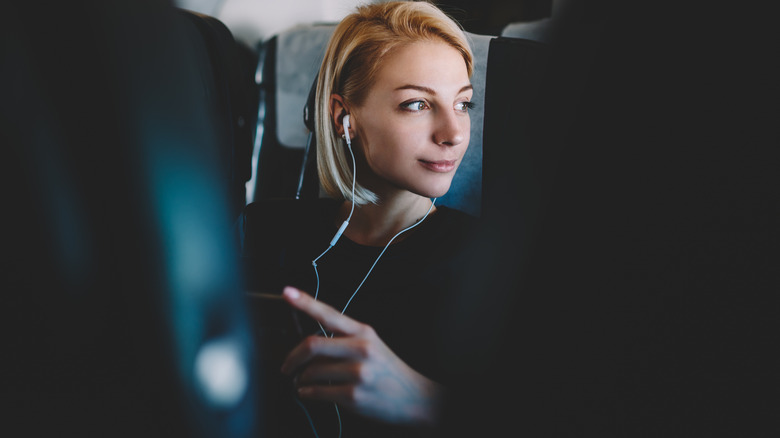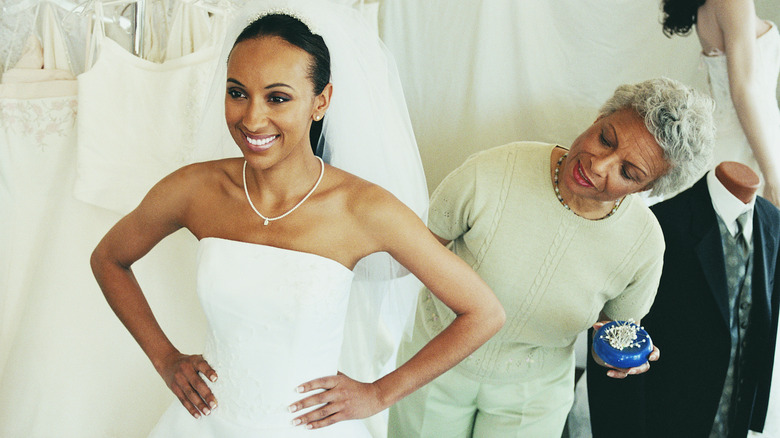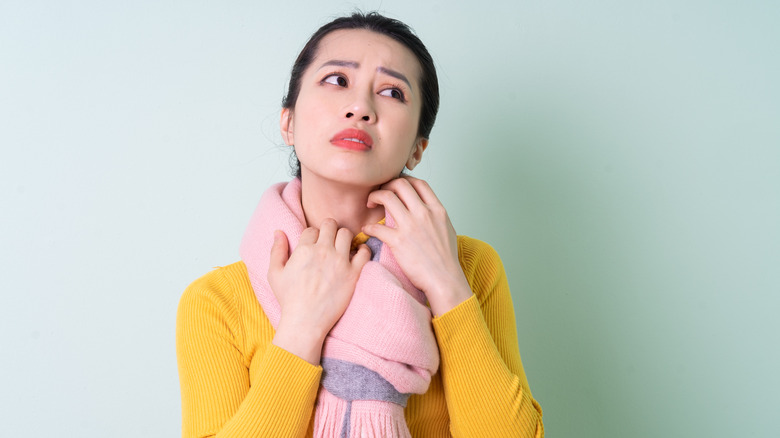15 Things You Should Never Wear On An Airplane
Flying is a complicated experience. Not only do you have to prepare months in advance by buying tickets, booking hotels, and planning transportation, but there's also the matter of dress to attend to. Who do you want to be when you land at your destination? Maybe you're flying to an important work conference and want to step into your CEO persona as you step off the plane. Or maybe you're embarking on a vacation to a tropical island, and the new person that awaits you is a flirtier, more adventurous version of yourself.
Either way, clothing plays a big part in making these dreams of travel and reinvention come true. Whether it's a pair of black pumps or that bathing suit you were waiting all winter to wear, packing your bag and planning out your airport look is one of the more exciting parts of preparing for air travel. However, as exhilarating as it can be to imagine flying in style, it's almost important to consider health, comfort, and safety protocols while up in the air.
As the name "airbus" entails, a plane is first and foremost a mode of transportation. We need to be sure that we are choosing clothes that lend themselves to small, cramped, and often dirty places. If you're planning a trip soon and find yourself daydreaming about what specific look you'll be serving at the airport, check out these top items you should never wear while flying.
1. Jeans
If you're a frequent flyer, you'll know that legroom is a big deal. Aisle seat? Window seat? Or perhaps even the dreaded middle seat? Before boarding your plane, it's important to strategize which seat option is going to give you the most space to get comfortable and stretch out those pesky forelimbs. However, one factor to leg comfortability that travelers often get wrong is what trousers to wear on your flight.
One form of outerwear that multiple experts have warned against while flying is jeans. Molly Fergus, the general manager of the travel site TripSavvy, tells Best Life: "It's best to avoid wearing skinny jeans on a lengthy flight. They limit movement and are likely more annoying to deal with in cramped, dirty airplane bathrooms."
Not only do jeans affect mobility and comfort, but they can also put your health at risk while you're up in the air. With the air pressure in the cabin increasing the higher the plane flies, the more likely you are to experience a unique form of bloating known as "jet belly." Another flight expert, Peter Hackett, M.D., who works as the director of the Institute for Altitude Medicine in Telluride, Colorado, explains to Condé Nast Traveler that "gas in the intestines will expand about 30 percent with a cabin altitude of 7,000 feet." For this reason, it is best to avoid any form of jeans that restrict your abdomen and instead opt for a form of trousers that have elastic around the waistband.
2. Tight clothes
Just as blue jeans can often be too restricting to wear comfortably on flights, many experts warn against wearing too-tight clothing in general. While it's only natural to want to look your best while traveling, especially if you're headed to a dream destination or a very professional business conference, it's important to wear breathable and loose clothes while flying. This is crucial not only for comfort but also for health reasons.
In addition to "jet belly," wearing constricting clothing while up in the air can cause even greater health issues, such as slowed blood circulation and even blood clots. A frequent condition that befalls airline passengers is deep vein thrombosis, otherwise known as DVT. This is a condition where blood clots form in the veins. The CDC warns that common areas of the body where these clots occur are the thighs, pelvis, legs, and arms. While DVT is preventable and often treatable, this condition has also been linked to more serious illnesses and disability, and sometimes even death.
With this in mind, many airline passengers who opt for tight trousers, bandage dresses, or bodycon looks may find themselves in deep trouble after takeoff. If you do find yourself mid-flight realizing that you may have accidentally dressed in too-tight clothing, an easy way to fight against DVT and other blood circulation issues is to drink plenty of water and to take advantage of that "seatbelts off" sign by walking around the cabin whenever possible.
3. Jewelry
For the fashionistas out there, this one might be a hard pill to swallow, but one accessory you should be careful about wearing on a flight is large, chunky jewelry. While most passengers will be able to wear their dainty jewelry pieces through airport security, those who wear bigger statement pieces might run into issues when trying to pass through airport security's metal detectors.
Now that you've been warned, this type of accessory is best kept inside a special jewelry case that you will be able to easily slot into your carry-on bag before boarding your plane. This way, those beautiful statement pieces will be ready to go when you land at your destination without being harmed, lost, or tangled beyond recognition as you try your best to navigate the commotion of the airport.
If you do choose to brave the skies with your bigger pieces of jewelry, be sure that each piece is insured. If your jewelry is especially valuable or expensive, it would also be wise to take photos of each piece for the benefit of the insurer just in case an item were to go missing or be stolen during your adventures. With this in mind, the smartest choice of all might be to simply forgo big jewelry when traveling by air.
4. Tank tops and shorts
If you're expecting to arrive at a tropical destination when your plane lands, you might be tempted to wear warm weather clothing such as a tank top or shorts. However, there are two major practical reasons why these clothing items might not be the smartest decision. One reason is temperature regulation. It's a known fact that airplanes are kept at a lower-than-average temperature while up in the air.
Travel + Leisure reports that an overheated plane puts passengers at risk of a condition known as hypoxia, where the body reacts to a lack of oxygen by fainting. To avoid these medical episodes, airlines like to keep their cabins at a nice, frosty temperature. For this reason, you might want to layer up over your vacation-ready tank tops and choose a more suitable trouser option when flying by air. In addition to crying babies and motion sickness, nothing dampens the excitement of travel like shivering in your seat the entire plane ride.
Another issue to consider when choosing what to wear on your flight is hygiene. One of the benefits of wearing long pants and sleeves on an aircraft is that you're body is shielded from the often-dirty surfaces of an airplane. However, if you opt for more skin-bearing apparel, your bare arms and legs will be in direct contact with the seats of the plane, and you can never be sure that you won't encounter some sticky substance or mysterious stain on your seat's surface.
5. Perfume
Speaking of medical episodes, wearing perfume or other fragrant sprays while on a plane can cause serious health problems and great degrees of discomfort for your fellow passengers. While it can be tempting to spritz up with your favorite fancy cologne or perfume before boarding a plane to a new European city or an exciting cosmopolitan destination, the rule of plane etiquette is to hold back and wait until the plane has landed before spraying ourselves with mysterious (albeit sweet-smelling) chemicals.
While most airlines nowadays will allow you to travel with perfume, Clever Journey warns that aircrew members do reserve the right to request that you refrain from spraying your fragrance during the flight. If you are met with complaints from aircrew or other passengers regarding your perfume during a flight, an easy way to remove the scent is to simply head to the bathroom and use a towel and some warm water to remove the overpowering fragrance.
Airport security is another reason why you might want to leave your perfumes at home. While almost every airport allows perfume to be carried onto the aircraft, there are a number of security measures that passengers must abide by. For instance, most airports outlaw oversized perfume bottles and mandate that these liquids be housed in a clear, plastic container. With these strict rules and the possible trouble perfumes might cause while up in the air, it's best that you wait to spritz up until your plane has safely landed.
6. High heels
Whether you're on your way to a friend's wedding, an important work conference, or another formal occasion, it's natural to think you might be able to wear your formal attire — heels and all — onto the plane to save time and trouble. However, what many passengers who go this route don't realize is that wearing high heels to the airport will only slow you down and cause more problems in the long run than if you choose more sensible footwear.
Airports are famously finicky places, with staff shortages and technical issues liable to extend your time spent in the airport way beyond what you ever imagined. It's not uncommon to see stranded travelers curled up in corners of the airport, waiting on a plane that has been delayed 4 hours, or to see harried passengers running at full speed to catch their plane after a security delay. If you find yourself in either of these situations while wearing heels, you'll probably be cursing your past self and yearning for a nice, comfy pair of sneakers.
Your safety is also something to consider. Flight attendant Andrea Fischbach tells Who What Wear that shoes with heels can impede airplane evacuation protocols. "High heels and backless sandals make it difficult to quickly evacuate the aircraft," Fischbach says. "If there is an evacuation and slides are required, your high heels will have to come off, as they can puncture the slide." Additionally, heals may also "hurt others if they go flying off somehow."
7. Large coats
Okay! So, we've established the fact that airlines like to keep their cabins cool for health reasons. We don't want any passengers passing out with a case of hypoxia, do we? However, it's also important to remind passengers that they shouldn't lean too hard the other way. One clothing item you should also avoid wearing while traveling by plane is overly large, bulky coats. While you may be worried about being plagued by goosebumps during your flight, the only airplane experience that would be equally as uncomfortable is a flight where you spend the entire duration sweating and overheating.
Ease of movement is another good reason why puffer jackets should be left at home. If you're traveling on an economy ticket, you'll be seated in a row that contains three seats. This means that there will be other passengers in close proximity during the duration of your flight. Constantly having to maneuver around your big jacket, such as taking it off and on to regulate your temperature, is likely to annoy your seatmates and create an uncomfortable situation for everyone involved.
If you're also thinking that a puffer-style jacket or coat might be easy to store in the overhead locker, think again. Not only will these types of jackets take up space that is designated for luggage, but the scuffing from suitcase wheels, spilled liquids, and other mishaps that occur in these overhead compartments make them the last place you would want to store a beloved puffer.
8. Wide-legged pants
Forbes reports that, while up in the air, a commercial airplane can carry anywhere between 150 and 350 passengers. That's a lot of complimentary packages of pretzels and a lot of carry-on bags; but more importantly, that's a lot of germs circulating around the cabin of the plane. To stay clean and healthy during your travels, it's important to make as little contact with airplane surfaces as possible, and that includes wearing clothing that also avoids grazing these surfaces.
With that said, wide-legged trousers might not be the best option when dressing for a flight. While this style of pant is incredibly fashionable and will look amazing as you strut down the streets of New York, LA, or whatever chic city you're flying to, they should be swapped out for a more comfortable and elasticated pair of pants that have a close-fitted hem.
Not only would wide-legged trousers graze the dirty aisle floors of the plane, but they could also make for a very unhygienic experience if you find yourself having to use the bathroom during your flight. Whether you're flying economy or first class, you can expect the airport bathroom to be incredibly small. This means that your beloved trousers will certainly be touching the unhygienic floor of the bathroom. If you need any more reason to leave the bell bottoms at home, just remember that the toilet flush button alone on an airplane is said to contain "265 bacteria colony forming units (CFU) per square inch."
9. Overalls and jumpsuits
Overalls: A quaint, comfortable choice of attire that might seem like the ideal choice for airplane travel. However, if you think about the practicalities of wearing overalls, jumpsuits, or any sort of one-piece attire on a plane, you'll probably think again about snapping those straps into place before leaving for the airport. While the denim-type material that most overalls are made of might make it seem perfect for the stain-prone experience of air travel, there's one aspect that might deter you, and that's the airplane bathroom experience.
In February 2023, the New York Post interviewed a series of flight attendants to spill the tea on airplane bathrooms. One flight attendant, who chose to remain anonymous, told the publication: "The airplane loo is essentially a cupboard, with no clean air. There is no window and the air ventilation is poor." The anonymous interviewee went on to say: "This means that every time you go to the loo, not only are you breathing in the air of many others who have 'done their business' before you (especially if it's a long-haul flight), but you could also be breathing in potential feces particles, circulating [in] the air after a toilet flush."
So let's think deeply about how much time you really want to spend in an airplane bathroom — overalls and jumpsuit-style clothing, with their intricate straps, will only extend the time we have to spend in an unventilated loo suspended thousands of feet in the air.
10. Underwire bras
A lot has been said about what outerwear we choose to don when we're going up on a plane, but let's take a minute to discuss underwear. When it comes to our breasts, choosing a supportive yet comfortable bra is paramount in planning your airplane outfit. While many people might be tempted to reach for the most fashionable outwear and underwear when planning their airport looks, any seasoned traveler will tell you that comfort trumps all, and nothing can ruin a comfy vibe more than a too-tight bra that digs into your skin.
Additionally, the Healthy Journal reports that bras with an underwire are especially unwise to wear during air travel. For those who are not in the know, an underwire is a thin strip of metal, plastic, or resin fitted inside the fabric of the bra to help lift one's breasts and shape their chest. While bras with underwires may be a wise choice for any formal occasion where you're invested in looking your best, these bras could set off airport metal detectors and also irritate your body during your flight.
While smaller-sized bras with underwires will most likely pass through airport metal detectors with no problem, the Healthy Journal warns that bigger-sized underwire bras will naturally possess an underwire that is "thicker and larger," and therefore will have "a higher chance of setting off the metal detector" at airport security.
11. Earbuds
Anyone who has been on a long-haul flight can tell you that headphones are a must. Whether it's a screaming baby or a loudly snoring passenger seated next to you, headphones not only block out any unwanted sound but also allow you to listen to your favorite wanderlust playlist or pop on a movie during your flight. If you're an anxious flyer or just someone who dreads turbulence, then headphones will also allow you to drown out all those mysterious jet-engine sounds and focus your attention on a relaxation video or breathing exercises.
However, as handy as headphones can be, many flight experts warn against using a particular type of headphone device while up in the air, and that's earbuds. As opposed to headphones that rest over your head and over the opening of your ears, earbuds — otherwise known as in-ear headphones — are a smaller, more portable alternative that you insert directly into your ear canal.
In-ear headphones or earbuds have inferior sound quality compared to their larger counterpart but also provide less protection from loud noises than what you would receive from a full headphone set. According to Regain Hearing, an airplane during takeoff can be as loud as 120 decibels (dB) or more, and because "anything over 70 dB can cause damage to your hearing, it's wise to use some form of protection." Unfortunately, earbuds just won't cut it.
12. Clothes made from synthetic fibers
Do you know what your clothes are made of? Chances are, probably not. In today's day and age, when clothing demand is higher than ever, trends change fast than the weather. Fast fashion is all the rage and most people have little idea where or how their clothes are being produced so it's important to bring awareness to issues of clothing sustainability and the risks of wearing synthetic fibers.
Sew Guide defines synthetic fibers as man-made and inorganically sourced from chemicals rather than naturally-occurring materials. These fibers have become incredibly popular because they're lightweight and flexible. However, people should also know that synthetic fibers are flammable — highly flammable. This may not hugely affect your day-to-day life, but if you're a frequent traveler or you have a big flight coming up, it would be wise to double-check the tags on your clothing to make sure that you won't be donning synthetically-made clothing while on the plane.
In the unlikely event of a plane fire, wearing synthetic fibers like nylon and polyester can be more flammable. Furthermore, the National Transportation Safety Board warns that 68% of plane crash deaths happen not during impact, but rather in "post-crash fires" (via Scientific American). For comfort and safety, it's best to wear natural fabrics such as cotton, linen, and wool that are breathable and can regulate your temperature depending on your environment.
13. Wedding dress
They say your wedding day is one of the happiest days of your life, but what's even more exciting than walking down the aisle to your one true love? Boarding a plane to your favorite city or an unexplored tropical island with your one true love. That's right, if anything is going to top the wedding ceremony itself, it's going to be the honeymoon. For the more adventurous nearlywed out there, you might even consider jet-setting straight off from your ceremony to the airport, donning your wedding dress, heels, and all!
However, there are specific steps you take when flying with your wedding dress (or any other important formal attire) to ensure that this once-in-a-lifetime gown will remain unstained and untorn for years to come. Rather than wearing your dress directly onto the flight or attempting to squeeze your dress into a checked bag along with all your honeymoon lingerie and other goods, most experts advise that you pack your wedding dress into a carry-on bag. This way, your special garment will never be out of sight.
Natasha Duff-Cole, the owner of Ladies of Lineage, also advises that it would be wise to carry your wedding gown onto the plane in a garment bag. Additionally, if you have multiple carry-on bags but want to keep extra tabs on the one containing your wedding dress, Duff-Cole recommends adding "a bright ribbon or tag so you can easily detect and differentiate it."
14. Itchy frabrics
How much can we really safeguard against an uncomfortable or awkward airplane experience? It's a question that has haunted travelers, bloggers, and philosophers for decades. There are approximately one million different factors that could determine what kind of flight experience we'll have, and it's a sad truth that many of them are simply down to chance.
For example, what are the weather conditions like on the day of your flight? If the airs are choppy or there's a storm brewing, you might be in for a turbulence-loaded experience. What sort of person purchased the seat next to you? If it's a chatty stranger looking to make a new friend, you'll probably be making brain-numbing small talk for the next few hours. However, there are a few steps we can take to make sure that our flight experience is, at the very least, as physically comfortable as possible. One way we can do this is to avoid clothes that are made of particularly itchy fabrics.
Who What Wear lists bamboo, wool, and polyester as the least "skin-friendly" fabrics, making these materials also the least plane-friendly fabrics. Wool is an especially heinous offender, as scientists have proven that wearing naturally-occurring wool — as opposed to synthetically-produced wool — can cause flare-ups of eczema and other dry skin-related disorders (via Healthline). Not only will avoiding these materials protect your precious epidermis in general, but it will also protect you from suffering avoidable itchy skin attacks and embarrassing discomfort during your flight.
15. Your favorite outfit
Okay, let's say you've managed to find the perfect outfit that isn't made of any synthetic fibers, has zero wool, possesses a close-fitted hem, and hits that perfect middle ground between keeping you warm and also letting your body breathe. You might be thinking, "Yes! This is my perfect air travel outfit!" While it might seem like a great find on the surface, it bears repeating that you should really think twice about donning any outfit that you deeply love or that holds sentimental value.
From departure boards flickering the names of exotic locations to the promise of a glass of wine up in the sky, flying is incredibly exciting. It's natural to want to choose a favorite outfit to wear as you embark on a new adventure. However, the best way to prevent any sartorial heartbreak is to choose an outfit that you won't mind getting stained or ruined.
The goal here is comfort and safety, not style. At the end of the day, an airplane is a tool to get us from place to place, and just like taxis or trains, by opting to climb aboard we are signing up to be exposed to spills, smears, smudges, and strangers sneezing on us. Let's protect ourselves from discomfort and potential injury by choosing not only clothes that are fitted the right way and made of the right material but also clothing we are happy to expose to the unpredictable world of air travel.
